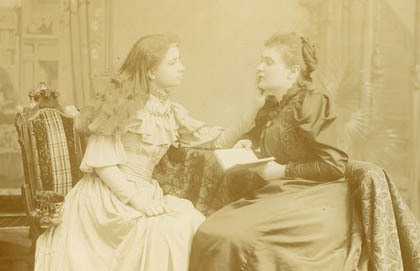Easter is when Christians celebrate the resurrection from the dead of a man from a tomb just outside of Jerusalem 2,000 years ago. There are lots of arguments to be raised as to why this should be considered reliable history but at the end of the day all of the evidence is only plausible if you believe in miracles.
But it’s not only at Easter and in relation to life’s “big questions” that miracles are relevant. If it weren’t for the reality of miracles, I, for one, would find the challenges that confront us each day to be overwhelming and beyond my capacity.
Last week, I took in Rosebud Theatre’s presentation of William Gibson’s The Miracle Worker, a play that tells the story of blind Helen Keller discovering language through the teaching of Annie Sullivan. It was a powerful experience, watching the very physical and frustrating struggle of a teacher and student working towards the seeming impossible. No spoiler alert is necessary—Helen’s successful learning of language is what has made the story so well-known. It’s the dramatic mix of perseverance, vision, and yes, miracle, that transports the audience to a world they can hardly understand.
Good art provokes our minds beyond the immediate experience to reflect on bigger questions and a broader application of the message communicated. I’ve found myself reflecting on Cardus’ work of Christian cultural engagement in light of my vicarious experience of Annie and Helen’s encounter. Three thoughts have emerged.
The first regards identity. Why was Annie able to make progress where the Keller family had failed? Annie saw the dignity and potential that Helen possessed; her family saw Helen as a blind and dumb child who needed to be taken care of. Annie had been taught to consider Helen’s impairments as “a little safe, locked, that no one can open.” But there was more: “Who knows? There may be a treasure inside.”
Effective cultural engagement requires an honest assessment of society. Society in general, just like each individual who is a part of it, has deformities and brokenness that is real. These can’t be ignored and must be addressed. But effective witness begins with our common identity. It is not “us” and “them” but “we” as a society who need to learn together if we are to flourish. A Christian social witness begins not with the fall and the evidence of brokenness, but with creation—and the human potential and hope for flourishing which God has placed into it. It is when we work with the possibility of sight and language in mind, convinced that this is the way God intended the world to be, that we ourselves can begin to be prepared for the difficult task ahead.
But it takes more than one key to unlock the treasure. The second theme involves persistence. Believing in miracles does not mean passively waiting for something to happen. Two hours of watching the play makes this clear. Most of the stage time is filled by just two people, one of whom cannot speak and whose unruly physicality creates an awkward discomfort and unease. The continuous wrestling between Annie and Helen is tiring even to watch.
And such is the work of cultural engagement.
It is repeating sign language over and over. As Annie reminds us, when the teaching of language is done out of genuine love rather than duty, perseverance becomes natural. Mrs. Keller, observing Annie teaching Helen sign language, realizes that Helen is simply mimicking without understanding. She asks Annie, somewhat credulously, “And when shall she learn?” Annie responds that when a mother teaches a child to talk, “no one bothers to count,” even if it takes a million repetitions. It is a love for God and neighbour that motivates the perseverance and repetitions required for a measurable cultural impact to be made, or not, as the case may be.
Which leaves the third reflection. Without the possibility of miracles, perseverance seems somewhat pointless. Annie can teach Helen sign language and a disciplined routine of teaching and learning can result in Helen becoming much better behaved and able to present much better at the family table. However, it takes a miracle to connect the signs for W-A-T-E-R with the spoken sound of “water” to the refreshing stream that flows from the pump.
Christian cultural engagement proceeds from a belief that God made the world for a purpose and that when humans live in communion with God and their fellow humanity, true freedom and flourishing can be experienced. The potential of creation has been spoiled by the brokenness of the fall, resulting in a general blindness to life’s purpose. But when those who have been blinded are able to see, to witness to the potential of redemption from their experience, they are compelled to share in whatever ways possible with their neighbours. And so we are called to model and to teach, not out of any expectation that our efforts can achieve the desired results, but knowing the hope of redemption and restoration are possible.
Yes, we believe in miracles. Happy Easter.







